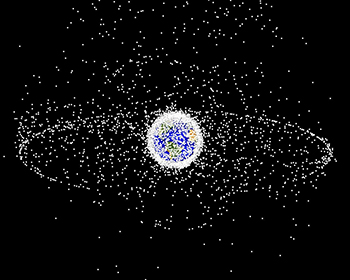Our Deteriorating Space Environment: A Status Report

Stephen Hawking, the physicist and cosmologist, thinks it is a near certainty we will destroy our planet with nuclear war, genetically engineered viruses, or climate change. In order to survive, he says, our species must establish settlements on other planets or their moons.
Hawking’s view of the future is much too rosy. The way things are going, space travel could become impossible before Earth becomes uninhabitable.
In 2011, the National Research Council reported the space debris problem had reached a tipping point in Earth orbit. Donald Kessler, who directed the study, said “we’ve lost control of the space environment.”
Now there is further pressure on this valuable natural resource. Companies are preparing to launch large constellations of spacecraft that will increase the active satellite population from 1400 to 7800 over the next few years. At a recent meeting of government officials, business executives, and university scientists that I attended, an aerospace engineer presented some sobering news. According to his calculations, the likelihood of a catastrophic collision between a piece of debris and a satellite, which currently is once every 2-3 years, will increase to 2-3 times per year.
There is growing concern that the probability of a runaway chain reaction of collisions, which would render space unusable and impassable for centuries to come, is increasing to dangerous levels. We are running out of time to address the debris problem and the answers are not going to be easy.
Because debris is growing exponentially as objects in space collide with each other, removing dead satellites and rocket bodies from orbits where collisions are most likely to occur is essential for stabilizing the space environment. This would reduce the volume of existing debris from which new debris can be created. Removing the 500 most dangerous objects, even at the slow rate of five to ten per year for the next 100 years, would solve much of the problem.
At General Synod 30 in Cleveland in 2105, delegates approved a resolution on responsible stewardship of the outer space environment. It called on UCC members to advocate with Congress to adequately fund NASA so it could lead the world in developing debris removal technologies. Unfortunately, there is no real institutional momentum or significant funding for research and development at this time.
The European Space Agency, though, has set an ambitious goal to conduct the world’s first debris removal mission in 2023. It will target a European-owned derelict satellite, attempt to capture it with a robotic arm or with a net, and then safely burn it up in a controlled atmosphere reentry.
Daunting technical problems will need to be solved before the mission can be attempted. Ray Sedwick, director of the Center for Orbital Debris Education and Research at the University of Maryland, offers this vivid description of the challenge: “Imagine trying to grab a spinning skater on an ice rink except instead of a person, it’s an SUV traveling over 17,000 miles per hour. And instead of you being there in person, you’re flying a drone, the lighting is bad, you have limited sensory data, there is no obvious place to grab onto, and you may be operating under a time delay.”
The legal and diplomatic issues associated with debris removal could be even more difficult to resolve. The “space garbage truck” of one nation will be viewed by others as a space weapon. If a country has the technical capability to grab one of its own satellites, it also could grab a satellite that belongs to an adversary.
General Synod 30 called on UCC members to support efforts by the U.S. and other nations to negotiate international agreements that encourage responsible behavior in space. But attempts to build the trust and confidence among space powers that will be needed for them to agree on what debris to remove and how to do it have failed.
The European Union, for example, tried to negotiate an International Code of Conduct for Outer Space Activities at the United Nations. The instrument would not have been legally binding but would have fostered cooperation by establishing norms of responsible behavior. The initiative was supported by the U.S. but opposed by China and Russia and failed to gain traction.
It remains to be seen whether the international community can achieve the technological breakthroughs and diplomatic progress needed to ensure a sustainable space environment.
One thing is certain. With over sixty countries operating in space, it will take an unprecedented level of international collaboration to solve the debris problem.
Rev. Robert Bachelder is Minister and President of the Worcester Area Mission Society, UCC in Massachusetts and author of the General Synod resolution on responsible stewardship of the outer space environment.
Related News
Can a Small Church Make a Difference on Environmental Justice? Yes!
American anthropologist Margaret Mead once observed, “Never doubt that a small group of...
Read MoreChurch Launches Community Composting Opportunity
Coral Isles Church in Tavernier, Florida recently kicked off a community composting...
Read MorePostcards for the Planet: Engaging Environmental Voters This Election Season
During this election season, the Green Christians at the Coral Gables United Church of...
Read More
